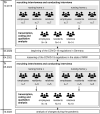Effects of the COVID-19 pandemic on hospice and palliative care in nursing homes-A qualitative study from a multiperspective view
- PMID: 37796817
- PMCID: PMC10553271
- DOI: 10.1371/journal.pone.0286875
Effects of the COVID-19 pandemic on hospice and palliative care in nursing homes-A qualitative study from a multiperspective view
Abstract
In Germany, nursing homes are characterised by challenging conditions for adequately supporting residents at their end of life, which have even amplified due to the COVID-19 pandemic. This article therefore analyses how hospice and palliative care in nursing homes has changed due to the COVID-19 pandemic and how the pandemic has affected residents, relatives and employees. Semi-structured interviews with employees, residents and relatives were conducted before and during the COVID-19 pandemic in two nursing homes in North Rhine-Westphalia, Germany. In a pre-post comparison, data were qualitatively evaluated using content analysis according to Mayring. Shifts, congruities and discrepancies in challenges in hospice and palliative care were identified between T0 and T1. Due to contact restrictions, important parts of end-of-life care were missing, and the roles of individuals providing hospice and palliative care were redefined. The interviewed groups experienced changes differently and contradictory statements on satisfaction and expectations about hospice and palliative care were reported. Employees and relatives predominantly perceived the pandemic to be very stressful, while residents endured this period more composedly. Employees stated that, despite the pandemic, they were mostly able to meet residents' requests. However, relatives and residents expressed that minor requests were not reliably fulfilled, neither at T0 nor at T1. Drawing together the different perspectives from employees, residents and relatives offers a bigger picture of challenges in hospice and palliative care in nursing homes and the pandemic effects. Stronger communication of requests and needs as well as greater collaboration, especially under crisis conditions, are essential for a better quality of end-of-life care. There is an urgent need to break down the taboos around the topics of dying and death in nursing homes.
Copyright: © 2023 Bußmann et al. This is an open access article distributed under the terms of the Creative Commons Attribution License, which permits unrestricted use, distribution, and reproduction in any medium, provided the original author and source are credited.
Conflict of interest statement
The authors have declared that no competing interests exist.
Similar articles
-
[Enhancement of hospice philosophy and palliative care competence in nursing homes for seniors through cooperation with an outpatient hospice care service : A practical example].Z Gerontol Geriatr. 2021 Feb;54(1):13-19. doi: 10.1007/s00391-020-01803-5. Epub 2020 Nov 13. Z Gerontol Geriatr. 2021. PMID: 33185720 Review. German.
-
Psychosocial burdens in palliative care - a longitudinal cohort study in nursing homes and impacts of the COVID-19 pandemic.BMC Palliat Care. 2023 Oct 28;22(1):163. doi: 10.1186/s12904-023-01292-4. BMC Palliat Care. 2023. PMID: 37891538 Free PMC article.
-
Delivering Hospice Care During the COVID-19 Pandemic: Meeting Nursing Home Residents' Needs.J Hosp Palliat Nurs. 2021 Oct 1;23(5):455-461. doi: 10.1097/NJH.0000000000000779. J Hosp Palliat Nurs. 2021. PMID: 34010231 Free PMC article.
-
[Implications for improving health care quality and patient safety of palliative residents in nursing homes: A qualitative study].Z Evid Fortbild Qual Gesundhwes. 2023 Sep;181:1-9. doi: 10.1016/j.zefq.2023.04.005. Epub 2023 Jul 11. Z Evid Fortbild Qual Gesundhwes. 2023. PMID: 37438168 German.
-
High-Quality Nursing Home and Palliative Care-One and the Same.J Am Med Dir Assoc. 2022 Feb;23(2):247-252. doi: 10.1016/j.jamda.2021.11.027. Epub 2021 Dec 23. J Am Med Dir Assoc. 2022. PMID: 34953767 Free PMC article. Review.
References
-
- Ewers M. Stationäre Langzeitpflege schwerkranker und sterbender Menschen—eine pflegewissenschaftliche Reflexion. Vortrag auf dem Fachtag „Das Sterben im Heim heute und morgen.”18.6.2018, Augsburg; 2018.
-
- Schwenk G. Pflegeheim und Hospizdienst: Kooperation in Spannungsfeldern. Zusammenwirken zweier Organisationstypen—eine qualitative Studie. Esslingen: Hospiz Verlag; 2017.
Publication types
MeSH terms
LinkOut - more resources
Full Text Sources
Medical


